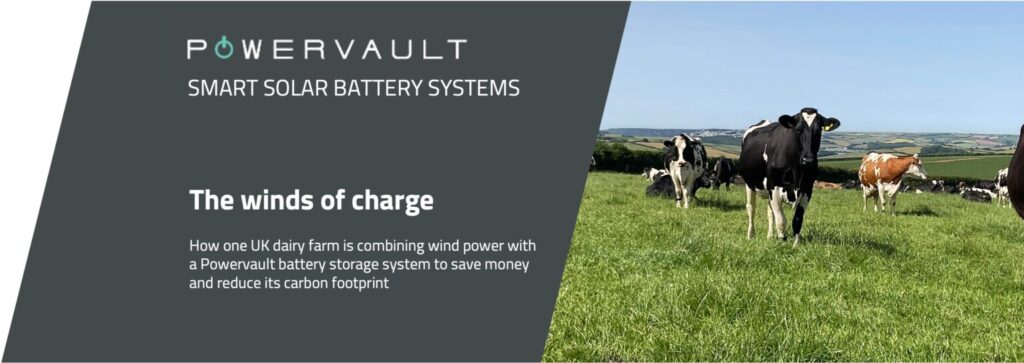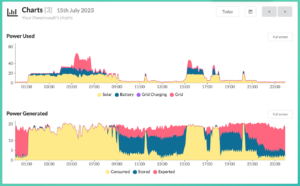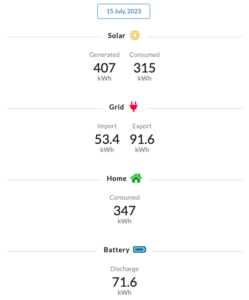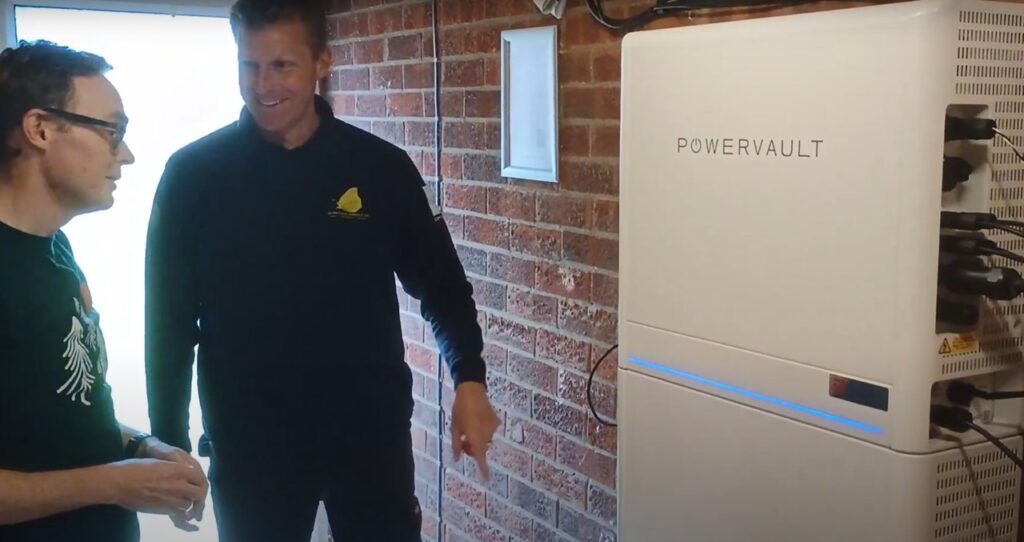
Case StudyThe winds of charge – how a UK dairy farm is combining wind power with Powervault battery storage
Overview
Toward the end of 2022, Melissa and Richard Darke of Coleridge farm invested in a Powervault smart battery storage system so they could make better use of the renewable energy they generate on site, reduce their energy bills, and simultaneously improve the eco rating of their farm.
Key facts
Existing Renewable Energy Generation
- 2x 11kW wind turbines installed in 2011 by Natural Energy UK
- 37MWh of generation per year
Powervault Energy Storage
- 3x 16kWh Powervault systems
- 60% reduction in exports (renewable energy generation ‘lost’ to the grid) in H1 2023
- Resulting in a 10,000kWh reduction in energy purchased from the grid per annum
- Payback of 6-7 years after capital allowances dependant on future energy prices
- Saving of 3.1 tonnes of CO2 (additional to wind generation alone) https://www.carbonindependent.org/15.html
Background
Melissa and Richard Darke, the owners of Coleridge Farm in Devon, installed two 11kW wind turbines in 2011 as a way to reduce their high imported energy costs and be more environmentally friendly. They had observed that their energy requirements were mismatched with their wind generation, particularly during the two daily milking rotas. Richard was frustrated at being forced to “chuck energy away to the grid” rather than being able to make fuller use of their wind turbines.
The obvious next step was to add a battery storage system, which would allow them to store the excess energy generated by the turbines and use it when they needed it, rather than relying on importing expensive energy from the grid. Finding a suitable solution was easier said than done, however.
Richard and Melissa were introduced to Powervault by Natural Energy UK, an Approved Powervault Installer responsible for the O&M of their two wind turbines.
A future-proof system
Working with Natural Energy, Powervault were able to analyse Coleridge Farm consumption data and specify a suitable energy storage installation. Natural Energy installed three 16kWh Powervault units – one on each of the Coleridge Farm’s three-phase electrical supply – giving a total storage capacity of 48kWh.
The modular design of the Powervault means that the right capacity for any installation can be specified for the customer’s needs while allowing the capacity to be increased over time as appropriate. The Powervaults generate very detailed data on the energy generation and use per phase on the farm.
The power of data


Powervault’s Portal user interface now allows close monitoring across the three-phase supply, showing the performance of the three Powervault units as a complete system and individually as they charge and discharge daily to optimise the Farm’s energy consumption.
On installation it was quickly noticed that wind turbine generation wasn’t quite as expected. Thankfully, the Powervault Portal provides a wealth of both live and historical data across the consumption and generation profiles of this complex system. This data allowed Powervault and Natural Energy UK to diagnose and fix a small issue with one of the wind turbines that may otherwise have gone unnoticed – an unforeseen benefit of the advanced Powervault analytics – that has increased the generation efficiency of the turbines.
Saving energy, carbon and money
After six months of operation, the battery storage system is working well and is projected to save 10,000kWh/year of electricity from being imported from the national grid.
Powervault have modelled that such a system, with capital allowances relief, should achieve a payback of 6-7 years. An estimate that could improve further if energy prices rise in the future at faster rate than currently forecast.
On top of the direct savings, Coleridge have been able to reduce their carbon footprint by an additional 3.1tonnes /year, which improves their eco rating. An important factor when considering the importance placed on ESG factors in modern food supply chains.
What’s next?
Richard and Mellissa tell us that they plan to add even more generation in the form of a solar array – furthering the opportunity to utilise the capacity of the Powervaults and reduce their electricity bill and carbon footprint. A system of wind turbines, solar PV and Powervault battery storage is a great combination.
Solar panels generate 75% of their energy in the summer and will work well with the wind turbines, which generate more in the winter months.
The electricity consumption profile of a dairy farm is concentrated around milking times, so Powervault storage makes sure that the excess renewable generation between milking times is stored and available when needed. As Richard and Melissa continue on their path towards a net-zero farm, Powervault’s UK-based team will be happy to help.
“We would definitely recommend Powervault, the team have been on hand to deal with all the complexities of working on a commercial dairy farm and have demonstrated a willingness to go above and beyond”
Richard and Melissa Darke, Coleridge Farm
*Investment in battery storage qualifies for 100% capital allowances which mean that for every pound that a business invests, their taxes are cut by 19p to 25p depending on their corporation tax rate.
Read more...Recent Case studies
Energy insight in your inbox
Subscribe to Powervault’s email newsletter and be the first to hear about new products, plus get all the latest news, analysis and insight from Powervault.


